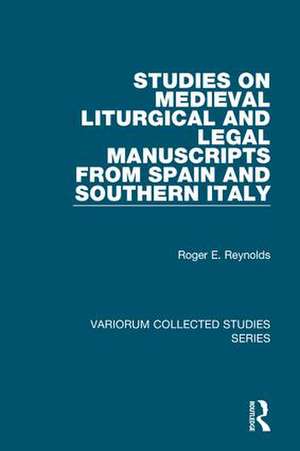Studies on Medieval Liturgical and Legal Manuscripts from Spain and Southern Italy: Variorum Collected Studies
Autor Roger E. Reynoldsen Limba Engleză Hardback – 28 oct 2009
Din seria Variorum Collected Studies
-
 Preț: 313.38 lei
Preț: 313.38 lei -
 Preț: 311.41 lei
Preț: 311.41 lei -
 Preț: 308.04 lei
Preț: 308.04 lei -
 Preț: 325.68 lei
Preț: 325.68 lei -
 Preț: 406.12 lei
Preț: 406.12 lei -
 Preț: 311.18 lei
Preț: 311.18 lei -
 Preț: 325.31 lei
Preț: 325.31 lei -
 Preț: 396.01 lei
Preț: 396.01 lei - 9%
 Preț: 1039.89 lei
Preț: 1039.89 lei -
 Preț: 266.20 lei
Preț: 266.20 lei -
 Preț: 358.42 lei
Preț: 358.42 lei - 9%
 Preț: 938.10 lei
Preț: 938.10 lei -
 Preț: 351.48 lei
Preț: 351.48 lei - 9%
 Preț: 938.86 lei
Preț: 938.86 lei -
 Preț: 335.37 lei
Preț: 335.37 lei - 9%
 Preț: 937.14 lei
Preț: 937.14 lei -
 Preț: 351.42 lei
Preț: 351.42 lei -
 Preț: 328.48 lei
Preț: 328.48 lei - 38%
 Preț: 766.84 lei
Preț: 766.84 lei - 23%
 Preț: 315.48 lei
Preț: 315.48 lei - 36%
 Preț: 740.06 lei
Preț: 740.06 lei - 38%
 Preț: 764.20 lei
Preț: 764.20 lei - 39%
 Preț: 684.75 lei
Preț: 684.75 lei - 29%
 Preț: 247.40 lei
Preț: 247.40 lei - 37%
 Preț: 488.89 lei
Preț: 488.89 lei - 38%
 Preț: 766.91 lei
Preț: 766.91 lei - 38%
 Preț: 769.51 lei
Preț: 769.51 lei - 38%
 Preț: 769.85 lei
Preț: 769.85 lei - 36%
 Preț: 823.43 lei
Preț: 823.43 lei - 25%
 Preț: 225.28 lei
Preț: 225.28 lei - 27%
 Preț: 225.54 lei
Preț: 225.54 lei - 38%
 Preț: 767.07 lei
Preț: 767.07 lei - 38%
 Preț: 764.20 lei
Preț: 764.20 lei - 36%
 Preț: 736.38 lei
Preț: 736.38 lei - 34%
 Preț: 738.43 lei
Preț: 738.43 lei - 27%
 Preț: 226.52 lei
Preț: 226.52 lei - 37%
 Preț: 491.66 lei
Preț: 491.66 lei - 37%
 Preț: 485.78 lei
Preț: 485.78 lei - 37%
 Preț: 485.78 lei
Preț: 485.78 lei - 38%
 Preț: 766.34 lei
Preț: 766.34 lei - 36%
 Preț: 739.17 lei
Preț: 739.17 lei - 34%
 Preț: 473.94 lei
Preț: 473.94 lei - 18%
 Preț: 843.63 lei
Preț: 843.63 lei - 38%
 Preț: 774.91 lei
Preț: 774.91 lei - 38%
 Preț: 769.92 lei
Preț: 769.92 lei - 38%
 Preț: 764.20 lei
Preț: 764.20 lei - 50%
 Preț: 488.81 lei
Preț: 488.81 lei - 36%
 Preț: 488.49 lei
Preț: 488.49 lei - 38%
 Preț: 769.10 lei
Preț: 769.10 lei - 38%
 Preț: 766.99 lei
Preț: 766.99 lei
Preț: 545.93 lei
Preț vechi: 843.43 lei
-35% Nou
Puncte Express: 819
Preț estimativ în valută:
104.46€ • 113.83$ • 88.03£
104.46€ • 113.83$ • 88.03£
Comandă specială
Livrare economică 02-16 aprilie
Doresc să fiu notificat când acest titlu va fi disponibil:
Se trimite...
Preluare comenzi: 021 569.72.76
Specificații
ISBN-13: 9780754659976
ISBN-10: 0754659976
Pagini: 330
Dimensiuni: 152 x 229 mm
Greutate: 0.7 kg
Ediția:1
Editura: Taylor & Francis
Colecția Routledge
Seria Variorum Collected Studies
Locul publicării:Oxford, United Kingdom
ISBN-10: 0754659976
Pagini: 330
Dimensiuni: 152 x 229 mm
Greutate: 0.7 kg
Ediția:1
Editura: Taylor & Francis
Colecția Routledge
Seria Variorum Collected Studies
Locul publicării:Oxford, United Kingdom
Cuprins
Contents: Preface; Part I Visigothica: The 'Isidorian' Epistula ad Massonam on lapsed clerics: notes on its early manuscript and textual transmission; The Visigothic liturgy in the realm of Charlemagne; Baptismal rite and Paschal vigil in transition in medieval Spain: a new text in Visigothic script; Visigothic-script remains of a Pandect Bible and the Collectio Canonum Hispana in Lucca; A Visigothic-script folio of a Carolingian collection of canon law; Utrecht fragments in Visigothic script; An early rule for Canons Regular from Santa Maria de l'Estany. Part II Beneventana: Monumenta liturgica Beneventana: new directions; The liturgy in Rome in the 11th century: past research and future opportunities; A homily in Beneventan script on the sacred orders, canonical hours, and clerical vestments (Vat. Borghese 186); Corpus Christi in Agnone; Canonistica Beneventana; The transmission of the Collectio Canonum Hibernensis in Italy from the 10th to the 12th century; A monastic florilegium from the Collectio Canonum Hibernensis at Montecassino; Further evidence for the influence of the Hibernensis in Southern Italy; The South Italian Collection in 5 Books and its derivatives: a South Italian appendix to the Collection in 74 Titles; The South Italian Collection in 5 Books and its derivatives: Maastricht excerpta; Gratian's Decretum and the Code of Justinian in Beneventan script; Addenda; Indexes.
Notă biografică
Roger E. Reynolds is Senior Fellow in Medieval Law and Liturgy at the Pontifical Institute of Mediaeval Studies in Toronto and a Professor of Medieval Studies in the Graduate Centre for Medieval Studies at the University of Toronto, Canada.
Descriere
Though the areas dealt with in this fourth set of studies by Roger Reynolds”the Iberian Peninsula and southern Italy”seem far apart, the materials covered illustrate that they are closely related, both in their differences and their similarities. Both peninsulas had their own indigenous liturgies and music, distinctive written scripts, and legal and theological traditions, and repeatedly these worked their influence on other areas of Western Europe. Despite efforts by the papacy and secular rulers from the 9th to the 13th century to suppress these distinctive traditions, elements nonetheless survived well into the 16th century and beyond. The articles in this volume also demonstrate the continued exchange of the distinctive customs between the Iberian Peninsula and southern Italian cultures from the very early Middle Ages through the 12th century.
